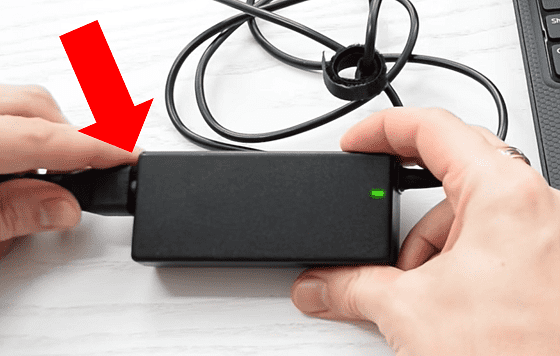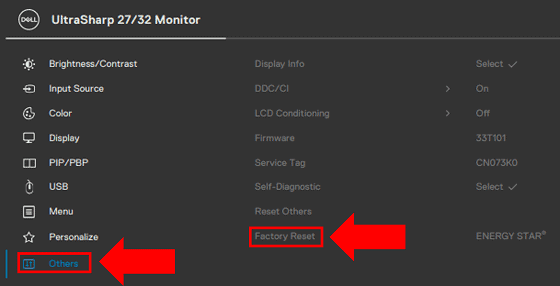My personal experience with Dell monitors goes back many years now and spans a number of different employers and workplaces.
As far as office monitors go, I have found them to be among the best. But that doesn’t mean they don’t require some troubleshooting every now and then.
Of all the issues I have encountered, one of the more common ones I came across was the screen not turning on at all. I quickly learned that there is a relatively short list of fixes to run through to get it functioning properly again.
If your Dell monitor won’t turn on, ensure the monitor power is actually set to ‘on’ and check the power and display cable connections. If the issue remains, double check the input and lower the display resolution. As a final measure, perform a factory reset.
In the event these display focused fixes don’t work, the connected device (whether PC or otherwise) may be causing the problem. To confirm, try using your monitor with a different device. Then update your Dell drivers and firmware and ensure display cable is properly plugged into the video card. Finally, reinsert RAM sticks and reset CMOS/BIOS.
While some of these steps sound a bit complicated, they are all fairly straightforward to implement. Let’s review step-by-step instructions for each of these fixes together and get your monitor up and running!
Step 1: Make Sure The Monitor Is ‘Actually’ Turned On
First, before we start spinning our wheels with more involved fixes, double check that monitor is actually turned On.
This sounds both dumb and obvious, I know. But since most folks only every turn their display on once and rarely need to again, this mistake is made more often than you might think.
You can find the power button on the front, bottom, or side panel of your monitor frame. Turn it off and back on again just to be sure.
Step 2: Inspect AC Adapter And Power Cable
Next, make sure that the power cable is firmly connected to the wall outlet and the corresponding power port on your display.
Oftentimes when users encounter this issue, the power cord is not securely connected on one end. This is particularly true if your power supply cord has an AC adapter as these typically also come with a cable port that can come loose over time.

Be sure to also examine the power cord and AC adapter for any obvious signs of damage.
If you have an AC adapter, unplug it and slowly plug it back in. You should be able to hear some popping and soft crackling sounds, indicating that the cord is working properly.
Finally, if you notice any kinks in the cable, straighten them out.
Step 3: Firmly Reconnect The Display Cable
Perhaps unsurprisingly, most of these same steps also apply for the display cable.
The most common display cables include USB-C, HDMI, DisplayPort (DP), VGA and DVI. Newer models typically use USB-C, HDMI or DP display cables, while older models use VGA or DVI.
Disconnect whichever cable you are using and then firmly reconnect it on both ends. A number of different Dell monitor failures, from DP signal errors to sound issues, can be caused if there is even a slight break in this connection.
Notably, if you are using a VGA or DVI cable, tighten the screws all the way to prevent future issues.
Step 4: Set Monitor To The Correct Input
It is equally important to make sure your monitor is set to the correct Input.
A properly connected display cable won’t fix anything if your monitor is set to a different display cable type than the the one your attempting to use!
If you are unsure which display connector you have, you can use this video below to help accurately identify it.
With your display cable type now identified, find the Input button on your monitor. The Input button can be found on the front, bottom, or side panel of your monitor frame.
For some Dell models there isn’t an Input button and instead you will need to pull up the On Screen Display (OSD) main menu and then use the monitor navigation to toggle to Input Source.

Select the Input Source that matches your display cable. If your model has the option, you can also try the Reset Input Source function.
Step 5: Lower Display Resolution Range
All monitors have a specific range of possible display resolutions that they can relay back to your computer or connected device.
A common mistake users make is accidently setting their connected device to a display resolution that is outside the range of what your monitor is capable of handling.
If this is the case, it could be the reason why your monitor is not turning on.
To fix this, reboot your computer using Safe Mode. For most PCs, you can enter Safe Mode by repeatedly turning your computer on and off until the Choose an option screen appears. Then select Troubleshoot > Advanced options > Startup Settings > Restart and finally select Safe Mode from the list of options.
In Safe Mode your computer will automatically use a lower display resolution than normal use.
This will allow you the opportunity to go into your computer’s resolution settings and select a lower standard display resolution.
On Windows, navigate to Start > Settings > System > Display and use the drop-down menu under Display resolution.

The easiest thing to do is to play around using some trial-and-error. Start at the lowest resolution range available and incrementally increase your resolution. Wait approximately 30 seconds between each update and see whether the monitor remains on.
If the monitor stops working at a specific range, you’ve gone to high. Go back and select the range one increment lower.
Step 6: Factory Reset Monitor
Sometimes resetting your monitor to its factory settings is enough to get your display back up and running.
Most Dell models allow you to perform a factory reset directly from the OSD main menu. Within the main menu, use the monitor buttons to navigate to Others or Other Settings and then select Factory Reset.

If you cannot locate this feature, enter your model number into the manual lookup and follow the instructions.
Step 7: Test Monitor With Another Device
If you have gotten this far without success, it is very likely that your monitor works just fine and it’s the connected device causing the problem.
To confirm this, try using your monitor with another device. This can be different desktop computer, laptop, game console, etc.
If your monitor display works, then you know your monitor is working properly and your hardware is the culprit.
Step 8: Update Dell Drivers And Firmware
If your hardware is in fact the problem your Dell drivers and firmware may be outdated.
Fortunately Dell makes these kinds of updates quite easy. Just follow these simple steps:
- Head over to the Drivers & Downloads page.
- Identify your monitor model number in the search field.
- See what updates are available by running the detect drivers scan.
- Select the driver update you wish to install.
If you run into any trouble, their Drivers and Downloads FAQs page is quite helpful.
Step 9: Ensure Display Cable Is Plugged Into The Video Card
Nearly all desktop PC’s have a dedicated on-board video card unit with corresponding connections on the back of your computer.
So if you are using a desktop PC, check that your display cable is inserted directly into the video card port and NOT the motherboard.
These ports can be located close together so take your time investigating this. If the display cable is connected to the motherboard you will not get any display feedback and all you will see if a black screen!
Step 10: Remove, Reorder, And Reinsert Your RAM Sticks
While often forgot about, improper RAM (Random Access Memory) sticks connections can cause a whole host of problems.
Many times RAM related issues result in not enough power getting delivered to your mouse and keyboard. The creates a helpful hint! If your mouse and keyboard are suddenly not functioning properly, the RAM sticks are probably loose.
To fix this, turn off your PC/laptop and unplug it. Next, properly ground yourself and open your hardware device. Then take each of the RAM stick fully out of their respective seats.
Finally reorder the sticks and reinsert them.
Step 11: Reset CMOS/BIOS
The Complementary Metal Oxide Semiconductor (CMOS) battery in your computer powers the Basic Input/Output System (BIOS) firmware which pretty much manages all of the essential functions of your computer.
Resetting your BIOS sets it back to its previous configurations. This can often fix a lot of different issues.
With the PC off and unplugged, remove the outer case and locate the CMOS battery on the motherboard.
The battery position can vary quite a bit depending on the make and model of your device. Look up the manual if you’re struggling to find it.

Next, pop out the battery and hold down the power button to drain all excess remaining power from the device. After about a minute, reinsert the CMOS battery back into your PC.
Finally, reboot your computer and check to see if your display is working.
Final Thoughts
If you encounter your Dell monitor not turning on, follow these 11 troubleshooting steps:
- Confirm monitor is ‘actually’ ON
- Inspect AD adapter and power cable
- Firmly reconnect the display cable
- Set monitor to correct Input
- Lower display resolution range
- Factory reset monitor
- Test monitor with another device
- Update Dell drivers and firmware
- Ensure display cable is plugged into video card
- Reinsert RAM sticks
- Reset CMOS/BIOS
If you’ve tried all of these fixes, and you’re still having monitor issues, you can contact Dell consumer & member purchase sales support at 1-877-717-3355 or chat with a live representative.
You can also check out your Dell warranty policy.

Chelsea Ashbrook is a Senior Manager of Corporate Digital Experience at Genentech. Chelsea received her B.A. from the University of Connecticut and has spent the last 11 years working in the technology field.

